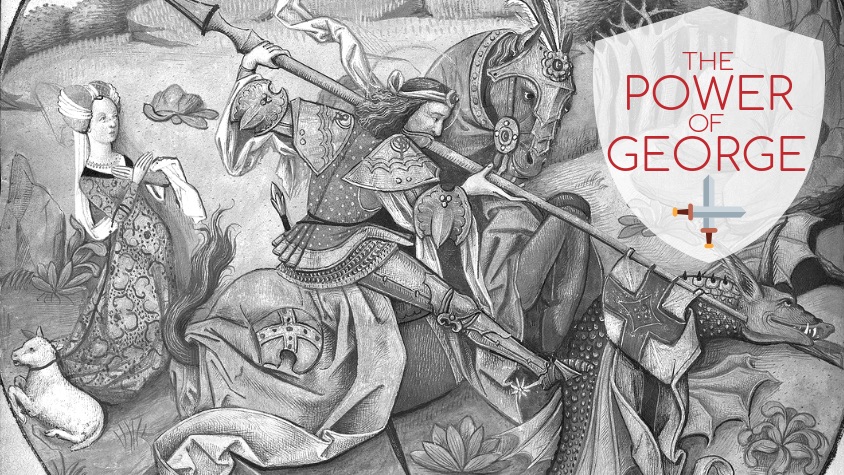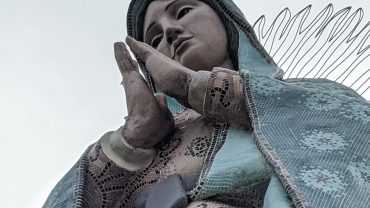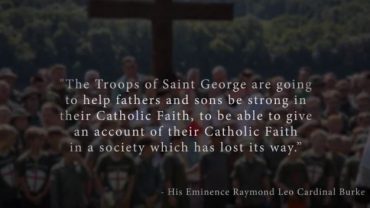

(SEPTEMBER 11, 2018) — My father was born in 1937, six months after George VI was crowned King of England. His daughter, Queen Elizabeth II, still reigns as the British Monarch after 66 years on the throne.
Since my dad was born in Canada, which is still part of the British Commonwealth, his parents named him George. I’ve always been partial to the name because I inherited George as my middle name.
Even though St. George is the patron saint of England—and, of course, the Troops of Saint George—most people don’t know much about him.
What we do know is this: George was a soldier in the Roman army before being martyred in the fourth century. Unfortunately, little else is known about his life with certainty. Throughout history, many songs, stories, poems, and hymns have been written about St. George, which has made it hard to separate fact from fiction.
The Golden Legend
The saint is most often portrayed in full armor, carrying a spear or sword and slaying a dragon. This image comes from the most famous of the St. George folklore called the Golden Legend, which is said to have taken place in Silene (modern-day Libya), where George may have been born. The town was plagued by a venomous dragon—some stories say it was an alligator—that townsfolk offered two sheep daily to keep it at bay. It soon wanted human sacrifice, so children were chosen by lottery.
One time the lot fell on the king’s daughter. The king offered all his gold and silver to have his daughter spared; the people refused. The daughter was sent out to the lake, dressed as a bride, to be fed to the dragon. Saint George by chance arrived at the spot. The princess tried to send him away, but he vowed to remain. The dragon emerged from the pond while they were conversing. Saint George made the Sign of the Cross and charged it on horseback, seriously wounding it with his lance.
Saint George offered to kill the dragon if [the townsfolk] consented to become Christians and be baptized. Fifteen thousand men including the king of Silene converted to Christianity. George then killed the dragon, beheading it with his sword, and the body was carted out of the city on four ox carts. The king built a church to the Blessed Virgin Mary and Saint George on the site where the dragon died, and a spring flowed from its altar with water that cured all disease. (Source: Wikipedia)
Fact or Fiction?
What do the legend of St. George and the dragon mean for us today? While some scholars question whether George himself is more of a legend than an actual saint, perhaps that may have something to do with the myth of the dragon.
Other scholars say George’s father was a Roman officer and his mother a Greek native of Lydda. Both were Christians from noble families and George was raised to follow their faith. As a young man, George joined Diocletian’s army. He soon rose to the rank of Tribune and served as an imperial guard for the emperor at Nicomedia.
On February 24, 303 A.D., Diocletian, who hated Christians, announced that every Christian the army passed would be arrested and every other soldier should offer a sacrifice to the Roman gods.
George refused to abide by the order and told Diocletian, who was angry but greatly valued his friendship with George’s father. Diocletian attempted to convert him to believe in the Roman gods, offered him land, money, and slaves in exchange for offering a sacrifice to the Roman gods, and made several other offers that George refused.
Finally, after exhausting all other options, Diocletian ordered George’s execution. In preparation for his death, George gave his money to the poor…. He was lacerated on a wheel of swords and required resuscitation three times, but still, George did not turn from God.
On April 23, 303 A.D., George was decapitated before Nicomedia’s outer wall. His body was sent to Lydda for burial, and other Christians went to honor George as a martyr. (Source: Catholic.org)
The Call to Holiness
Regardless of the whether St. George’s story is truth or legend, the lesson is clear—God calls each of us to sanctity. Sanctity requires faith, and heroism is necessary to live the faith boldly—particularly in today’s post-modern, post-Christian society.
Saint George clearly inspired the early Church with his heroic life of virtue. He is the patron saint of chivalry, soldiers, knights, horsemen, scouting, skin ailments, and many other causes including various cities and countries throughout the world, most notably England.
The Roman empire crumbled and was replaced by a Christian culture because early Christians lived their faith publicly and boldly. Saint George left a legacy of bold, public faith. No less is called for in our day and age—particularly the young men and fathers who make up the Troops of Saint George.
PATRICK NOVECOSKY is a seasoned Catholic speaker, journalist and thought leader who runs NovaMedia and blogs at The Praetorium and for TSG in collaboration with iAmplify.



